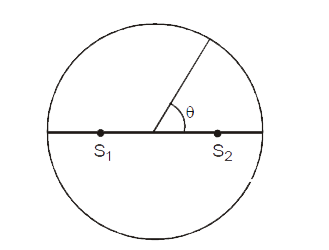A source of sound S and a detector D are placed at some distance from one another. A big cardboard is placed near the detector and perpendicular to the line SD as shown in figure. It is gradually moved away and it is found that the intensity changes from a maximum to a minimum as the board is moved through a distance of 20 cm. Find the frequency of the sound emitted. Velocity of sound in air is 336ms−1.

The correct Answer is:B, D
According to the given data, V=336ms
λ4= distance between maximum and minimum intensilty =20cm
→λ=80cm
→n=equency=Vλ
=336)80x10−2)=420Hz
Topper's Solved these Questions
Similar Questions
In Quincke's experiment the sound detected is changed from a maximum to a minimum when the sliding tube is moved through a distance of 2.50 cm. Find the frequency of sound if the speed of sound in air is 340ms−1.
View SolutionIn Quincke's experiment the sound detected is changed from a maximum to a minimum when the sliding tube is moved through a distance of 2.50 cm. Find the frequency of sound if the speed of sound in air is 340ms−1.
View Solution
Knowledge Check
Vibrating tuning fork of frequency v is placed near the open end of a long cylindrical tube. The tube has a side opening and is fitted with a movable reflecting piston. As the piston is moved through 8.75 cm, the intensity of sound changes from a maximum to minimum, if the speed of sound is 350 m/s. Then v is
 A500 HzB1000 HzC2000 HzD4000 Hz
A500 HzB1000 HzC2000 HzD4000 HzVibrating tuning fork of frequency n is placed near the open end of a long cylindrical tube. The tube has a side opening and is fitted with a movable reflecting piston. As the piston is moved through 8.75cm, the intensity of sound changes from a maximum to minimum. If the speed of sound is 350m/s. Then n is
 A500HzB1000HzC2000HzD4000Hz
A500HzB1000HzC2000HzD4000HzVibrating tuning fork of frequency n is placed near the open end of a long cylindrical tube. The tube has a side opening and is fitted with a movable reflecting piston. As the piston is moved through 8.75cm, the intensity of sound changes from a maximum to minimum. If the speed of sound is 350m/s. Then n is
 A500 HzB1000 HzC2000 HzD4000 Hz
A500 HzB1000 HzC2000 HzD4000 Hz
A source S and a detector D are placed at a distance d apart. A big cardboard is placed at a distance √2d from the source and the detector as shown in figure. The source emits a wave of wavelength =d2 which is received by the detector after reflection from the cardboard. It is found to be in phase with the direct wave received from the source. By what minimum distance should the cardboard be shifted away so that the reflected wave becomes out of phase with the direct wave ?

View SolutionA source S and a detector D are placed at a distance d apart. A big cardboard is placed at a distance √2d from the source and the detector as shown in figure. The source emits a wave of wavelength =d2 which is received by the detector after reflection from the cardboard. It is found to be in phase with the direct wave received from the source. By what minimum distance should the cardboard be shifted away so that the reflected wave becomes out of phase with the direct wave ?

View SolutionA source S and a detector D are placed at a distance d apart. A big cardboard is placed at a distance √2d from the source and the detector as shown in figure. The source emits a wave of wavelength =d/2 which is received by the detector after reflection from the cardboard. It is found to be in phase with the direct wave received from the source. By what minimum distance should the cardboard be shifted away so that the reflected wave becomes out of phase with the direct wave?

View SolutionA source of sound emitting a 1200 Hz note travels along a straight line at a speed of 170ms−1. A detector is placed at a distance of 200 m from the line of motion of the source. (a) Find the frequency of sound received by the detector at the instant when the source gets closest to it. (b) Find the distance between the source and the detector at the instant it detects the frequency 1200 Hz. Velocity of sound in air=340ms−1.
View SolutionTwo point sources of sound are placed at a distance d and a detector moves on a straight line parallel to the line joining the sources as shown in figure. At a distance D away from sources. Initially Detector is situated on the line so that it is equidistant from both the sources. Find the displacement of detector when it detects nth maximum sound and also find its displacement when it detects nth minimum sound.

View Solution
